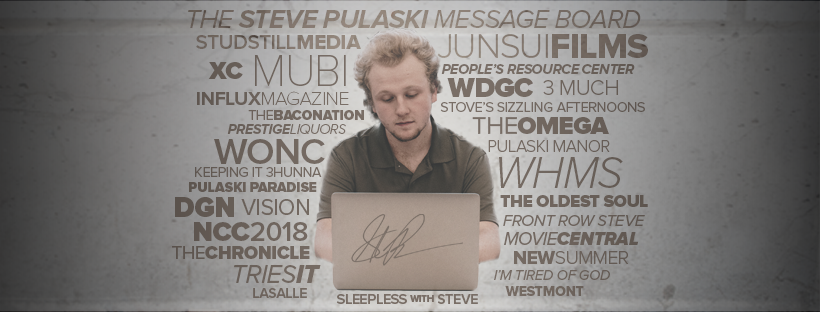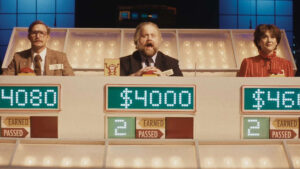The Luckiest Man in America (2025) review
Dir. Samir Oliveros
By: Steve Pulaski
Rating: ★★★
My dad and I don’t agree on a whole lot. I love movies. He claims there hasn’t been a good movie made since Dirty Harry. That said, growing up, some of my earliest childhood memories revolve around the two of us watching TV. Game shows were common in our house, specifically Supermarket Sweep and Press Your Luck. Both dazzled me — still do, honestly — and I distinctly remember contestants repeated exclaims of “big bucks, big bucks, no Whammies” deliriously exciting me. This was usually followed up by my father turning around to yell at me: “Steven, quit jumping on the damn couch!”
The flashing lights, the oscillating stage, Whammy animations, and Peter Tomarken’s innocent wit all captivated a four/five-year-old Steven, who couldn’t contain his energy and had to get it out of his system by doing something. Not until I was in high school did I learn about the famous 1984 Press Your Luck scandal, when a small-time huckster successfully cracked the pattern of the flashing lights on the show’s game board and subsequently racked up a record payout for any game show at the time.

The Luckiest Man in America is not only a fitting dramatization of the scandal itself, but it also is true to its subject matter insofar that it provides a strange snapshot in TV history. Its staying power will likely be minimal. Much like the story of Michael Larson, the film is an oddity to be brought up in casual conversation, or a gab and chatter at the bar. It succeeds in being a snapshot of a time when game shows were simple and unglamorous, and further proof that the camaraderie behind the cameras can sometimes be just as entertaining.
Paul Walter Hauser plays Michael Larson because of course he does. The actor has an uncanny ability to portray slightly unhinged oddballs with endearing glimmers of humanity. He did it in I, Tonya, and then again in Richard Jewell, to emotional success. He does it once more. Larson is a liar from the moment we meet him, in the audition room for Press Your Luck, the 1980s game show, pretending to be someone else. He’s caught pretty early on, but the show’s co-creator, Bill Carruthers (David Strathairn), takes a liking to the small-town Ohio native who drove his ice cream truck all the way to Hollywood for a chance to be on the show. Chuck (Shamier Anderson), the casting director, doesn’t buy his ruse, but he’s overruled.
Larson lands on the show, and following an early brush with a Whammy — the cartoon thief who steals money from contestants unlucky enough to “stop” on one of his squares — Larson starts winning and winning big. He keeps pressing the button to “stop” at the exact right moment, wracking up thousands of dollars in minutes. Carruthers, along with the show’s producers and board operators, are initially overjoyed. Then they get suspicious. As Larson’s winnings climb into the $50k and $60k range, they realize that the payout is going to cost that of a couple people’s salaries, potentially theirs. Then they get on the defense.

With Hauser as the star, there is still enough room for a gaggle of supporting performers to shine. Strathairn is great as Carruthers, who slowly segues from delighted to downtrodden. He tasks Chuck to do some research on Larson, resulting in a series of sequences that are developed for sheer plot convenience. Walton Goggins expertly channels Tomarken’s quick wit and radiant charisma; both men would be neck-in-neck in a competition of charming a dog off a meat-wagon. Even Johnny Knoxville shows up in the eleventh hour as a fictional talk show host. Larson breaks from the Press Your Luck action to appear on the show in a strange scene that doesn’t really add up to much other than to elongate this story to feature-length.
The Luckiest Man in America features some drop-dead gorgeous production design Lulú Salgado. Despite being set in the mid-1980s, the film achieves the look of the 1970s, complete with warm, muted colors and fuzzy film grain. The Press Your Luck set looks absolutely immaculate, with cinematographer Pablo Lozano effectively juggling the bright lights of the game show floor and the slowly suffocating walls of the producers’ room.

The film was cowritten by director Samir Oliveros and Maggie Briggs, both of whom try to bring stray fragments of Larson’s real life into the show itself with mixed results. This move proves most successful in the third act when the tone matches that of a horror movie. Larson starts to feel like a prisoner within the game. Like a true snake-in-the-grass, he feels like he’s the one being manipulated. Certain bits feel contrived, such as the phone call to Larson’s alleged wife, and when Larson wanders off for long stretches of time between filming, the innerworkings of movie magic start to show their seams.
No less, The Luckiest Man in America is great entertainment. For those like me who embrace television history, actively keeping the memory of everything from the Max Headroom signal hijacking to Pants-Off Dance-Off alive, it’s gratifying to see a story as bizarre as this one given such careful attention-to-detail with few other motives besides being a satisfying watch.
Starring: Paul Walter Hauser, Walton Goggins, David Strathairn, Maisie Williams, Shamier Anderson, Brian Geraghty, Patti Harrison, and Johnny Knoxville. Directed by: Samir Oliveros.
About Steve Pulaski
Steve Pulaski has been reviewing movies since 2009 for a barrage of different outlets. He graduated North Central College in 2018 and currently works as an on-air radio personality. He also hosts a weekly movie podcast called "Sleepless with Steve," dedicated to film and the film industry, on his YouTube channel. In addition to writing, he's a die-hard Chicago Bears fan and has two cats, appropriately named Siskel and Ebert!


